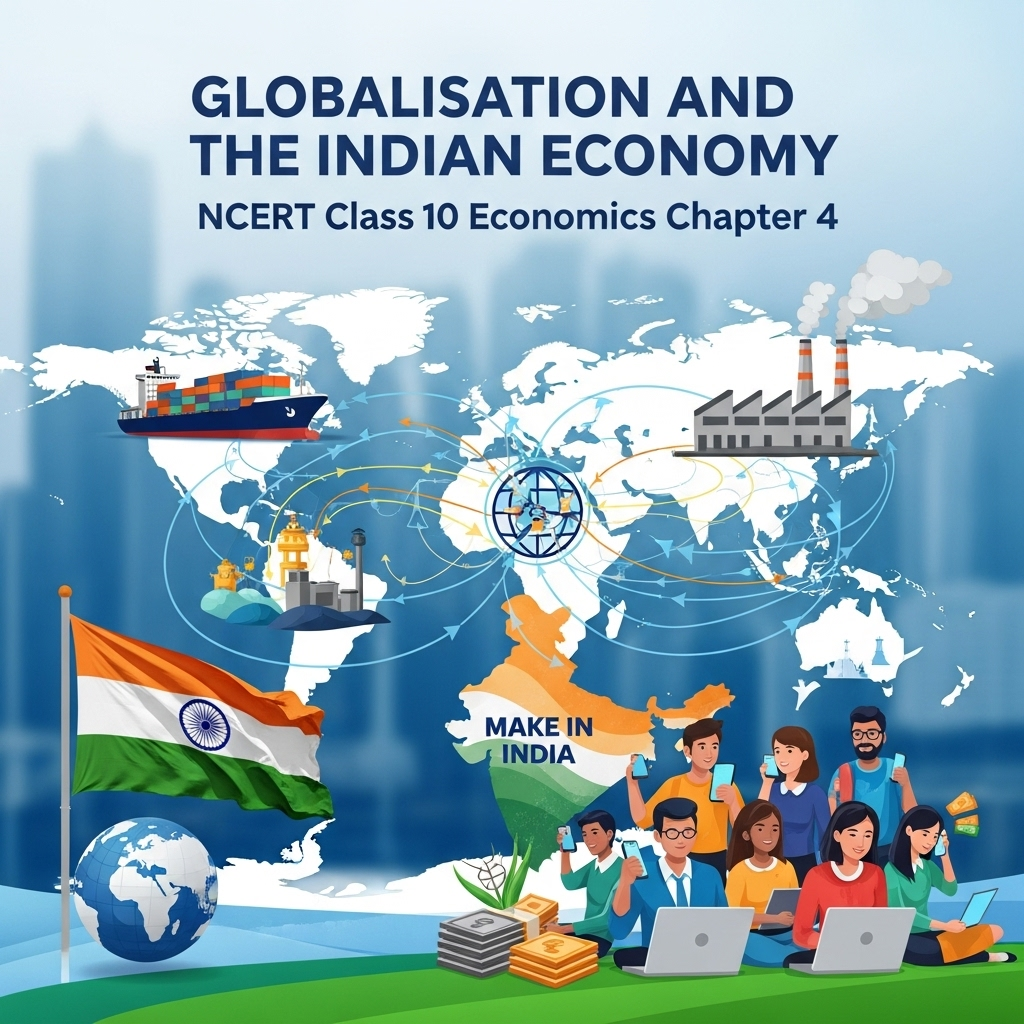Complete Solutions and Summary of Globalisation and the Indian Economy – NCERT Class 10, Economics, Chapter 4 – Summary, Questions, Answers, Extra Questions
Comprehensive summary and explanation of Chapter 4 'Globalisation and the Indian Economy', covering the meaning and impact of globalisation, role of multinational corporations (MNCs), integration of markets, liberalisation, technology, trade and investment policies, WTO, benefits and challenges of globalisation for India, and its effects on production, development, and local communities—with all question answers and extra questions from NCERT Class X Economics.
Updated: 2 months ago
Categories: NCERT, Class X, Economics, Summary, Extra Questions, Globalisation, Indian Economy, MNCs, Liberalisation, Technology, Trade, WTO, Chapter 4

Globalisation and the Indian Economy
Chapter 4: Economics - Complete Study Guide | NCERT Class 10 Notes & Questions 2025
Comprehensive Chapter Summary - Globalisation and the Indian Economy Class 10 NCERT
Overview and Teacher Notes
- Chapter Purpose: Explores globalisation as integration through foreign trade and investments by MNCs. Focuses on economic aspects, excluding portfolio investments. Key Insight: MNCs drive globalisation by connecting regions. Use examples (Indian context) to illustrate ideas, not quantitative data.
- Key Concepts: Integration of production/markets; MNCs' role. Ensure clarity before proceeding. Factors: Technology improvements, trade/investment liberalisation, WTO pressures.
- Teaching Tips: Pre-liberalisation era role-play; WTO discussions on power imbalances. Impact: Link to development goals (Chapters 1-2). Local examples like import effects on farmers.
- Sources: ILO (www.ilo.org) for fair globalisation; WTO (www.wto.org) for agreements; MNC websites; Corporate Watch (www.corporatewatch.org.uk) for critiques.
- Expanded Relevance 2025: Post-COVID, focus on supply chains, digital globalisation. Update: India's Atmanirbhar Bharat vs global integration.
- Exam Tip: Distinguish MNC ways; use examples like Ford, Cargill; know liberalisation pros/cons.
- Broader Implications: Globalisation offers choices but unequal; fair globalisation needed for workers/small producers.
Introduction to Globalisation
- Wide Choice of Goods: Consumers access global brands (cameras, mobiles, TVs, cars like Ambassador to global models, shirts, fruit juices). Markets transformed in years from limited variety.
- Rapid Transformations: Factors: MNCs, trade, investments. Impacts lives; questions transformations' drivers and effects.
Production Across Countries
- Historical Context: Until mid-20th century, production within countries; trade in raw materials/food/finished goods (e.g., India exported raw, imported finished).
- MNCs Emergence: Own/control production in multiple nations; set up for cheap labour/resources to lower costs, earn profits.
- Spreading Production Example: MNC designs in US, components in China, assembly in Mexico/Eastern Europe, sales global, customer care in India. Cost-savings 50-60%.
- Global Production: Process divided globally; advantages: Cheap manufacturing (China), market proximity (Mexico/Europe), skilled engineers/English speakers (India).
Interlinking Production Across Countries
- MNC Setup Factors: Market proximity, low-cost skilled/unskilled labour, production factors availability, favourable govt policies.
- Foreign Investment: Spending on assets (land, buildings, machines); hope for profits. Called foreign investment.
- Joint Production: With local companies; benefits: Additional investments (new machines), latest technology.
- Buying Local Companies: Expand production; e.g., Cargill bought Parakh Foods (marketing network, refineries); now largest edible oil producer in India (5M pouches/day).
- MNC Wealth/Power: Exceeds developing countries' budgets; immense influence.
- Orders to Small Producers: Garments, footwear, sports; MNCs determine price/quality/delivery/labour; sell under own brands.
- Interlinking Ways: Partnerships, supplies, competition/buyouts; production dispersed but linked.
Foreign Trade and Integration of Markets
- Historical Trade: Routes connected India/South Asia to East/West; attracted companies like East India Company.
- Function of Foreign Trade: Producers reach beyond domestic markets; compete globally; buyers get expanded choices.
- Chinese Toys Example: Manufacturers export to India; cheaper/new designs; 70-80% shops replaced Indian toys; greater choice/lower prices for buyers; losses for Indian makers.
- Market Integration: Goods travel; choices rise; prices equalise; producers compete across miles.
What is Globalisation?
- MNCs Role: Seek cheap production locations; rising foreign investment/trade; MNCs control much trade (e.g., Ford exports from India).
- Global Activities: Substantial goods/services trade by MNCs.
Factors that have Enabled Globalisation
- Technology: Rapid improvements; transport (containers, air); IT (internet, telecom) connect globally, reduce costs.
- Liberalisation of Trade/Investment: Remove barriers (taxes, quotas) for free flow.
- Trade Barriers: Tax on imports (protect domestic); quotas limit quantities.
- Liberalisation: Remove govt restrictions; flexible policies attract foreign capital/technology.
- WTO: Liberalise international trade; 164 members; rules for all, but developed countries unfair (subsidies while pressuring developing to remove barriers).
Impact of Globalisation in India
- Positive: MNCs investments; new jobs; better technology/quality; greater consumer choice/competition; rising standards.
- Negative: Small producers compete/disinvest/close; workers flexible/less secure jobs; unequal benefits.
- Govt Role: Liberalisation with protection for vulnerable; ensure fair globalisation.
The Struggle for a Fair Globalisation
- Fairness: Equal opportunities; benefits shared; protect labour rights, small producers, environment.
- Govt Measures: Labour laws enforcement; small producer support; negotiate WTO for fair rules; align with developing countries.
SEO Note: Why This Guide?
Top-ranked for 'Globalisation Class 10 notes 2025'—free, with 60 Q&A from PDF, quizzes. Integrates economic insights.
Key Themes
- Economic Integration: Trade/investment links.
- MNCs Strategies: Spread production, interlink.
- Policy Shifts: Liberalisation impacts.
- Critical Thinking: Pros/cons; fair globalisation.
Cases for Exams
Use Ford/Cargill examples; discuss WTO fairness; analyze toy market competition.
Exercises Summary
- Focus: Expanded to 60 Q&A from PDF: 20 short (2M), 20 medium (4M), 20 long (8M) based on NCERT exercises + similar.
- Project Idea: Debate on globalisation impacts; map MNC operations.
Group Discussions
No forum posts available.


